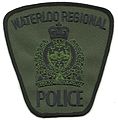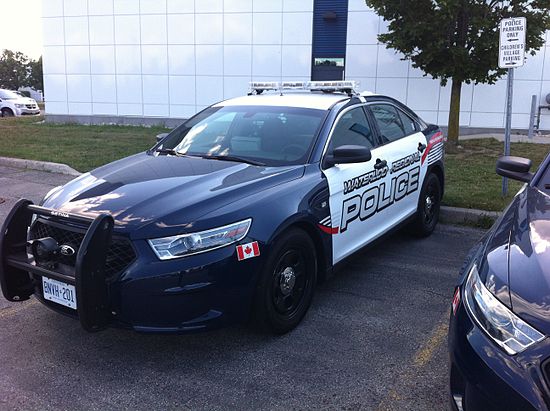Waterloo Regional Police Service
| Waterloo Regional Police Service | |
|---|---|
| The patch for the WPRS The patch for the WPRS | |
 The WPRS logo | |
| Agency overview | |
| Formed | 1973 |
| Annual budget | $140,000,000 (2014) |
| Jurisdictional structure | |
| Operations jurisdiction | Waterloo Region, Ontario, Canada |
| Size | 1,382 km² or 533.59 sq mi |
| Population | 560,000 (2014) |
| Operational structure | |
| Headquarters | Cambridge, Ontario |
| Sworn members | 800 |
| Elected officer responsible |
|
| Agency executive |
|
| Divisions | 5 |
| Facilities | |
| Stations | Headquarters; 3 Stations; 2 Sub-stations |
| Website | |
| Waterloo Regional Police Service | |
The Waterloo Regional Police Service (WRPS) provides policing services for the Regional Municipality of Waterloo in Ontario, Canada which encompasses the cities of Waterloo, Kitchener, and Cambridge, as well as the townships of North Dumfries, Wellesley, Wilmot and Woolwich. WRPS was established in 1973 to replace the individual police departments in the region. The cities of Kitchener, Waterloo and Galt; Towns of Preston, Hespeler, Elmira and New Hamburg; the Village of Bridgeport and Waterloo Township had their own respective police department. The Townships of Woolwich, Wellesley, Wilmot and North Dumfries were under the jurisdiction of the Ontario Provincial Police. In 1991 Waterloo Regional Police Force was renamed with the current name.[1]
Organization
Since December 12, 2007, former Deputy Chief Matt Torigian replaced retiring Chief of Police Larry Gravill. A position which Larry Gravill held since 1992. In 1991, to minimize the negativity associated with the word "force", the department changed its name from Waterloo Regional Police Force to Waterloo Regional Police Service.
Headquarters
Headquarters is located at 200 Maple Grove Road on the border with Cambridge and Kitchener. This site was chosen as it is geographically center to all the urban areas within the region. Waterloo Regional Police headquarters has a museum in the lobby complete with old uniforms, equipment and information on the departments prior to 1973.
Operational Patrol Divisions
NORTH Formerly Division 3- 45 Columbia St. E., Waterloo
CENTRAL Formerly Division 1- 134 Frederick St, Kitchener
SOUTH Formerly Division 2- 176 Hespeler Rd, Cambridge
RURAL NORTH Formerly Division 3A- 13 Industrial Dr, Elmira
RURAL SOUTH Formerly Division 1A- 34 Peel St, New Hamburg
Branches & Divisions
Waterloo Regional Police Service is made up of:
Patrol Divisions
- NORTH Division - Serving the City of Waterloo, and areas of Kitchener not served by Central Division
- CENTRAL Division - Serving the City of Kitchener (East of Victoria Street, south of Belmont Ave to Highland and south of Westmount to Highway 7/8)
- SOUTH Division - Serving the City of Cambridge, and areas of Kitchener (Doon South, Trillium Industrial Park, Parkway, Hidden Valley)
- RURAL NORTH - Serving Woolwich and Wellesley Township
- RURAL SOUTH - Serving Wilmot and North Dumfries Township
All divisions also each have a Criminal Investigations Branch.
Investigative Services
- Homicide
- Major Case Unit
- Fraud Branch
- Traffic Services
- Forensic Identification
- Domestic Violence Unit
- Elder Abuse
- Traffic
- Collision Reporting Center
- Technical Crime Unit
Strategic & Tactical Services (Division 7)
- Special Response Unit
- Drug Branch
- Intelligence
Support Services
- Communications Branch
- Records Branch
- Evidence Management
- Court Services
- Information Technology
Community & Corporate Services
- Community Resources
- Human Resources
- Training Branch
- Quality Asuurance
Policing Standards
- Public Complaints
Executive Office
- Media Relations
- Emergency Planning
- Research & Planning
- Business Planning
Shoulder Flashes
Shoulder Flashes worn on the uniforms of Waterloo Regional Police Officers.
-
Standard Officer Flash
-
Senior Officer Flash
-
Emergency Response Team Black
-
Emergency Response Team Green
-
Old Shoulder Flash
Fleet

Currently in use:
- Ford Crown Victoria Police Interceptor
- Police Interceptor Sedan Ford Interceptor Sedan and Sport Utility Vehicles
- Dodge Magnum
- Chevrolet Impala
- Ford Econoline Van
- GMC Savana
- Mercedes Benz Sprinter Vans - Identification Unit
Marked cruisers are white, with hood, trunk lid, front and rear quarter panels and bumpers painted navy blue. The words Waterloo Regional Police appear in white retroreflective text with a navy blue outline. A distinct solid red line curves from the front, through to the rear of the vehicle, with the motto "People Helping People" and "911" on the rear quarter panel. A series of white horizontal stripes appear above and below the curved red stripe. The crest of the police service appears on the rear pillar as well. A Canadian flag in addition to any special designations for the vehicle, such as "Supervisor", "Traffic", "Duty Officer" are displayed on the front fender. On the rear of the cruiser, the text "Waterloo Regional Police" is displayed on the left side of the trunk lid, and the vehicle number and divisional designation (where applicable) on the right side. On the bumper appears the police service website (wrps.on.ca), along with the Crime Stoppers tip-line number encompassed by retroreflective chevrons. Affixed to the roof is a red and blue LED light bar, as well as several antennas for communication and GPS.
The WRPS Traffic Branch also employs marked "stealth" cars, which features the same markings, except in a retroreflective black-on-black design.
Previously:
New Fleet Cars
-
2013 Ford Taurus
-
2013 Ford Taurus - New in 2012
-
Waterloo Regional Police Pickup Truck
-
Dodge Magnum Police Interceptor
Officer Ranks
The rank structure used by the WRPS is defined by regulations of Ontario's Police Services Act.
- Chief of Police (Crown and three maple leaves)
- Deputy Chief (Crown and two maple leaves)
- Superintendent (Crown)
- Inspector (Two maple leaves)
- Staff Sergeant (Crown and three chevrons)
- Sergeant (Three chevrons)
- Constable
The Waterloo Regional Police Service does not use the ranks of Staff Superintendent or Staff Inspector.
Auxiliary Unit
The Waterloo Regional Police Service also has an auxiliary unit, composed of approximately 75 unpaid civilian volunteers.[2] Auxiliary Officers assist with special events, parades, as well as community programs.
See also
References
- ^ http://wrps.theorchardstudios.com/history
- ^ "http://wrps.on.ca/volunteers/auxiliary".
{{cite web}}: External link in|title=










